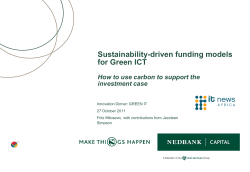
2014-IP16: UN Climate Summit
IEAGHG Information Paper; 2014-IP16: UN Climate Summit – Ban Ki-moon Final Summary At the end of the Climate Summit in New York, UN Secretary General Ban Ki-moon summarised the outcome. He told the assembled leaders: “This was a great day!” His full summary of the outcomes of the summit follows: The purpose of the 2014 Climate Summit was to raise political momentum for a meaningful universal climate agreement in Paris in 2015 and to galvanize transformative action in all countries to reduce emissions and build resilience to the adverse impacts of climate change. I asked leaders from government, business, finance and civil society to crystallize a global vision for low-carbon economic growth and to advance climate action on five fronts: cutting emissions; mobilizing money and markets; pricing carbon; strengthening resilience; and mobilizing new coalitions. An unprecedented number of world leaders attended the Summit, including 100 Heads of State and Government. They were joined by more than 800 leaders from business, finance and civil society. This Summary details their most significant announcements. Convergence on a Long-Term Vision A comprehensive global vision on climate change emerged from the statements of leaders at the Summit: World leaders agreed that climate change is a defining issue of our time and that bold action is needed today to reduce emissions and build resilience and that they would lead this effort. Leaders acknowledged that climate action should be undertaken within the context of efforts to eradicate extreme poverty and promote sustainable development. Leaders committed to limit global temperature rise to less than 2 degrees Celsius from preindustrial levels. Many leaders called for all countries to take national actions consistent with a less than 2 degree pathway and a number of countries committed to doing so. Leaders committed to finalise a meaningful, universal new agreement under the United Nations Framework Convention on Climate Change (UNFCCC) at COP-21, in Paris in 2015, and to arrive at the first draft of such an agreement at COP-20 in Lima, in December 2014. Leaders concurred that the new agreement should be effective, durable and comprehensive and that it should balance support for mitigation and adaptation. Many underlined the importance of addressing loss and damage. Many leaders affirmed their commitment to submit their Intended Nationally Determined Contributions (INDCs) for the new agreement in the first quarter of 2015. Many leaders reaffirmed the objectives and principles of the UNFCCC, including the principles of equity and common but differentiated responsibilities. In addition, others highlighted that the global effort to meet the climate challenge should reflect evolving realities and circumstances. Cutting Emissions Without significant cuts in emissions by all countries, and in key sectors, the window of opportunity to stay within less than 2 degrees will soon close forever: Many leaders, from all regions and all levels of economic development advocated for a peak in greenhouse gas emissions before 2020, dramatically reduced emissions thereafter, and climate neutrality in the second half of the century. European Union countries committed to a target of reducing emissions to 40 per cent below 1990 levels by 2030. Leaders from more than 40 countries, 30 cities and dozens of corporations launched largescale commitment to double the rate of global energy efficiency by 2030 through vehicle fuel efficiency, lighting, appliances, buildings and district energy. The New York Declaration on Forests, launched and supported by more than 150 partners, including 28 government, 8 subnational governments, 35 companies, 16 indigenous peoples groups, and 45 NGO and civil society groups, aims to halve the loss of natural forests globally by 2030. Twenty-four leading global producers of palm oil as well as commodities traders committed to contribute to the goal of zero net deforestation by 2020 and to work with Governments, private sector partners and indigenous peoples to ensure a sustainable supply chain. The transport sector brought substantial emissions reduction commitments linked to trains, public transportation, freight, aviation and electric cars. Some of the world’s largest retailers of meat and agricultural products committed to adapt their supply chains to reduce emissions and build resilience to climate change. They will assist 500 million farmers in the process. Moving markets and mobilizing money Moving markets across a wide range of sectors is essential for transforming economies at scale. Mobilizing sufficient public and private funds for low carbon, climate resilient growth is essential to keep within a less than 2 degree Celsius pathway: A new coalition of governments, business, finance, multilateral development banks and civil society leaders announced their intent to mobilise over $200 billion for financing low-carbon and climate-resilient development. Countries strongly reaffirmed their support for mobilising public and private finance to meet the $100 billion dollar goal per annum by 2020. Leaders expressed strong support for the Green Climate Fund and many called for the Fund's initial capitalization at an amount no less than $10 billion. There was a total of $2.3 billion in pledges to the Fund's initial capitalization from six countries. Six others committed to allocate contributions by November 2014. The European Union committed $3 billion for mitigation efforts in developing countries between 2014 and 2020. The International Development Finance Club (IDFC) announced that it is on track to increase direct green/climate financing to $100 billion a year for new climate finance activities by the end of 2015. Significant new announcements were made on support for South-South cooperation on climate change. Leaders from private finance called for the creation of an enabling environment to undertake the required investments in low-carbon climate resilient growth. They announced the following commitments: Leading commercial banks announced their plans to issue $30 billion of Green Bonds by 2015, and announced their intention to increase the amount placed in climate-smart development to 10 times the current amount by 2020. A coalition of institutional investors, committed to decarbonizing $100 billion by December 2015 and to measure and disclose the carbon footprint of at least $500 billion in investments. The insurance industry committed to double its green investments to $84 billion by the end of 2015. Three major pension funds from North America and Europe announced plans to accelerate their investments in low-carbon investments across asset classes up to more than $31 billion by 2020. Pricing carbon Putting a price on carbon will provide markets with the policy signals needed to invest in climate solutions. Seventy-three national Governments, 11 regional governments and more than 1,000 businesses and investors signalled their support for pricing carbon. Together these leaders represent 52 per cent of global GDP, 54 per cent of global greenhouse gas emissions and almost half of the world’s population. Some leaders agreed to join a new Carbon Pricing Leadership Coalition to drive action aimed at strengthening carbon pricing policies and redirecting investment More than 30 leading companies announced their alignment with the Caring for Climate Business Leadership Criteria on Carbon Pricing. Strengthening resilience Strengthening both climate and financial resilience is a smart investment in a safer, more prosperous future. A variety of innovative resilience initiatives were announced at the Summit, including many that will strengthen countries and communities on the climate front lines. These include an initiative to provide user-friendly “news you can use” climate information for countries around the world. Leaders agreed to strengthen and scale up the risk financing mechanisms for Africa and the Caribbean. The African Risk Capacity announced an expansion of its services and coverage, including the introduction of Catastrophe Bonds. An initiative to integrate climate risk into the financial system by 2020 was launched by a coalition of investors, credit ratings agencies, insurers and financial regulators in response to the growing number of extreme weather events. Leaders from the insurance industry, representing $30 trillion in assets and investments committed to creating a Climate Risk Investment Framework by Paris in 2015. Mobilizing New Coalitions Governments, business and civil society are creating the coalitions needed to meet the full scope of climate challenge. Leaders welcomed multilateral and multi-stakeholder actions between Governments, finance, the private sector, and civil society to address emissions in critical sectors and support adaptation and resilience, especially in Small Island Developing States, Africa and the Least Developed Countries. Leaders from 19 countries and 32 partners from Government, regional organisations, development institutions and private investors committed to creating an 8,000 kilometre-long African Clean Energy Corridor. The Global Alliance for Climate-Smart Agriculture, comprised of 16 countries and 37 organisations, was launched to enable 500 million farmers worldwide to practice climatesmart agriculture by 2030. Leaders of the oil and gas industry, along with national Governments and civil society organisations, made an historic commitment to identify and reduce methane emissions by 2020. A second industry-led initiative was launched by leading producers of petroleum who committed to address methane as well as other key climate challenges, followed by regular reporting on ongoing efforts. Industry leaders and Governments also committed to reduce HFCs in refrigeration and food storage A new Global Mayors Compact, representing well over 2,000 cities pledged new commitments on climate action supported by new funding from public and private sources -228 cities have voluntary targets and strategies for greenhouse gas reductions, that could avoid up to 2.1 gigatonnes of greenhouse gas emissions per year. A new coalition of more than 160 institutions and local Governments and more than 500 individuals committed to divesting $50 billion from fossil fuel investments within the next three-five years and reinvest in new energy sources. Panels comprised of eminent global leaders, policy experts and citizen activists discussed the need for, and multiple benefits of, accelerated climate action. Panellists focussed on the need for science-based decision making; strengthening economic performance while cutting emissions, generating jobs and enhancing resilience; pricing and reducing pollution for improved health; mobilizing new coalitions to help move markets; and ensuring that the most affected are at the centre of the global response to climate change. The Way Forward to Lima, Paris and beyond I thank all the leaders from Government, business, finance and civil society who came to New York with ambition and commitment. If we want the vision laid out by leaders from Government, finance, business, and civil society throughout the day, we must fulfil and expand on all the pledges and initiatives announced today. We must maintain the spirit of commitment and action that characterized the Summit. As we look forward to Lima, later this year, and Paris in December 2015, let us look back on today as the day when we decided – as a human family – to put our house in order to make it sustainable, safe and prosperous for future generations. Today’s Summit has shown that we can rise to the climate challenge. 30/09/2014
© Copyright 2025





















